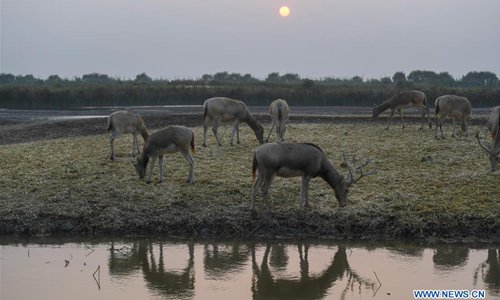Population of milu in China exceeds 8,000 amid wildlife protection efforts
Source: Global Times Published: 2020/11/8 23:08:52

Elks forage at Hangzhou Bay national wetland park in Ningbo, east China's Zhejiang Province, Oct. 24, 2018. (Xinhua/Huang Zongzhi)
China has basically achieved the goal to restore milu deer population as the number of the animal exceeded 8,000, after 25 adult milu deer were recently released into the wild.
The milu deer were released on November 6 in the Dafeng Milu National Nature Reserve in East China's Jiangsu Province. Their movement are being tracked by GPS, China News Service reported Sunday.
The latest release takes the total number of milu deer in China to more than 8,000 among whom 5,681 are in Dafeng, accounting for more than 60 percent of the world, which indicated that China has basically achieved the goal to restore the milu deer population.
Milu deer, or David's deer, are native to the middle and lower reaches of the Yellow River and the Yangtze River in China. It is a first-class national protected animal. It is also called "Sibuxiang" in Chinese because its antlers resemble a deer's, while its head looks like a horse, its hooves are like an ox and its tail resembles a donkey's.
The Dafeng reserve is one of the three milu deer protective areas in China with the other two in Beijing and Shishou, Central China's Hubei Province. It is also the world's largest milu deer protection area and the most complete milu deer gene bank, media reported.
In 1986, only 39 milu deer were living in the Dafeng reserve. China started to release milu deer in 1993.
In recent years, China's wildlife protection laws and regulations system has been gradually improved, habitat conditions have been significantly improved, and remarkable achievements have been made in the rescue and protection of endangered species. The population of China's unique species represented by milu deer shows a good trend of expansion.
The number of birds in Longbao National Nature Reserve in Qinghai reached 121, up from seven new species this year, according to the latest bird survey results Wednesday.
In 1989, China's wildlife protection law came into effect, and a system of wildlife protection from the central to the local and even to the township level was established. At the same time, a legal system focused on wildlife protection law began to take shape. It took China 30 years to build a nature reserve covering 15 percent of its territory.
Posted in: SOCIETY